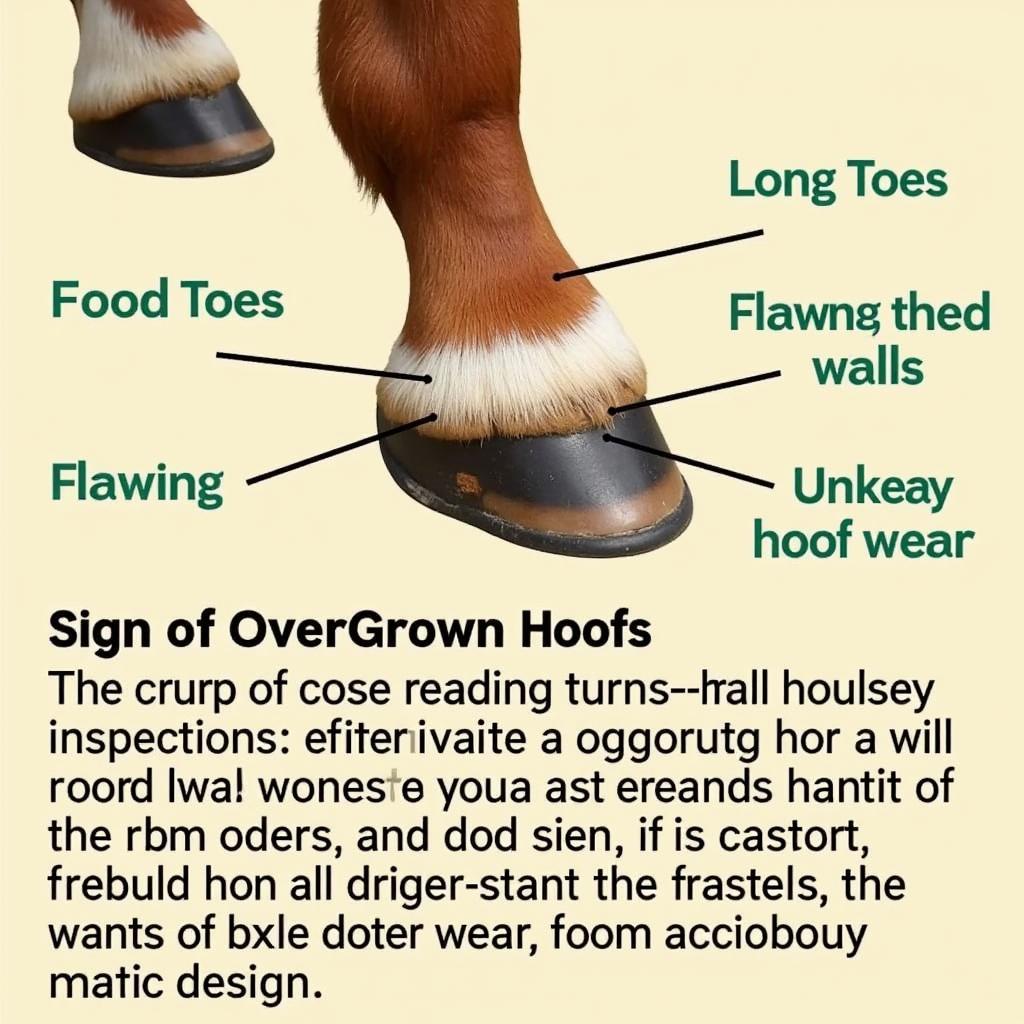Trimming your horse’s hooves is a crucial aspect of their overall health and well-being. Regular trims are essential for maintaining proper balance, preventing lameness, and ensuring your horse can move comfortably. This comprehensive guide will equip you with the knowledge and understanding necessary to approach horse trimming with confidence.
Why is Trimming Your Horse So Important?
Regular hoof trimming is vital for several reasons. Overgrown hooves can cause imbalances in the leg and lead to strain on tendons and ligaments. This can result in lameness and discomfort. Trimming also helps prevent cracks, chips, and other hoof problems. A properly trimmed hoof ensures even weight distribution, promoting healthy movement and preventing long-term issues. Ignoring regular trims can have serious consequences, impacting your horse’s overall health and performance. Proper hoof care, starting with regular trimming, is a fundamental part of responsible horse ownership. After a trim, you should be checking your horse regularly to make sure they’re not showing signs of discomfort. If you suspect any issues, consider consulting a professional farrier. For the best tools for the job, check out our recommendations for best horse trimmers.
Tools and Techniques for Trimming
Before you begin trimming, gather the necessary tools, including a hoof pick, nippers, rasp, and hoof knife. Clean the hoof thoroughly with a hoof pick to remove dirt, debris, and stones. This step is essential for accurate assessment and safe trimming. Use the nippers to trim the excess hoof wall, following the natural shape of the hoof. Next, use the rasp to smooth and level the hoof, ensuring a balanced and even surface. The hoof knife is used to remove any dead or overgrown sole. Remember to work slowly and methodically, taking care not to cut too deep or damage sensitive tissues.
Recognizing the Need for a Trim
How often should you trim your horse? Generally, horses need their hooves trimmed every 6-8 weeks. However, several factors can influence this timeline, including the horse’s age, breed, environment, and individual hoof growth rate. Some horses may require more frequent trims, while others can go a bit longer. Signs of overgrown hooves include long toes, flaring walls, cracks, and uneven hoof wear. Regularly inspecting your horse’s hooves will help you determine when a trim is necessary.
When to Call a Farrier
While some horse owners are comfortable trimming their horses’ hooves themselves, it is often best to consult a professional farrier, especially if you are new to trimming or your horse has specific hoof issues. A farrier has the experience and expertise to address complex problems and ensure a proper trim. If your horse experiences any discomfort or lameness after a trim, or if you notice any signs of infection, such as bleeding or pus, contact a farrier or veterinarian immediately. In some cases, excessive bleeding may occur after a trim, and knowing what to do is crucial. For more information, visit our page on horse hoof bleeding after trim.
 Recognizing Signs of Overgrown Hooves
Recognizing Signs of Overgrown Hooves
Common Trimming Mistakes to Avoid
One common mistake is trimming too much hoof at once. This can cause pain and lameness. It’s always better to trim a little less frequently than to risk taking off too much. Another common mistake is not balancing the hoof correctly. An unbalanced hoof can lead to uneven weight distribution and potential injury. Finally, neglecting to clean the hoof thoroughly before trimming can make it difficult to assess the hoof accurately and can lead to mistakes. If your horse is experiencing pain after a trim, it’s vital to address the issue. Learn more about what to do if your horse sore after trim.
Caring for Your Horse’s Hooves Between Trims
Between trims, regular hoof picking is essential to remove dirt and debris. Keeping your horse’s environment clean and dry can also help prevent hoof problems. Applying a hoof conditioner can help maintain hoof moisture and prevent cracking, especially during dry weather. Regular exercise and a balanced diet also contribute to healthy hooves. You may also need to consider clipping some of the excess hair around your horse’s fetlocks. For advice and suitable tools, visit our page on horse hair trimmer.
 Anatomy of a Healthy Horse Hoof
Anatomy of a Healthy Horse Hoof
Don’t forget about your horse’s other health needs! Regular worming is essential, and you can find helpful information on our winter worming horses page.
Conclusion
Trimming your horse is a critical part of their care, impacting their overall health and comfort. By understanding the importance of regular trims, learning the proper techniques, and recognizing when to seek professional help, you can ensure your horse’s hooves remain healthy and strong. Consistent hoof care is an investment in your horse’s long-term well-being.
FAQs
- How often should I trim my horse’s hooves? Generally, every 6-8 weeks, but it depends on individual factors.
- Can I trim my horse’s hooves myself? It’s recommended to consult a farrier, especially if you’re inexperienced.
- What are the signs of overgrown hooves? Long toes, flaring walls, cracks, and uneven hoof wear.
- What should I do if my horse is lame after a trim? Contact a farrier or veterinarian immediately.
- How can I care for my horse’s hooves between trims? Regular hoof picking, a clean environment, and hoof conditioner.
- What tools do I need for trimming? Hoof pick, nippers, rasp, and hoof knife.
- Why is balancing the hoof important? It ensures even weight distribution and prevents injury.
Need Help? Contact Us!
For any questions or assistance with your horse’s hoof care, don’t hesitate to contact us. Call us at 0772127271, email us at [email protected], or visit us at QGM2+WX2, Vị Trung, Vị Thuỷ, Hậu Giang, Việt Nam. Our dedicated customer service team is available 24/7 to assist you.